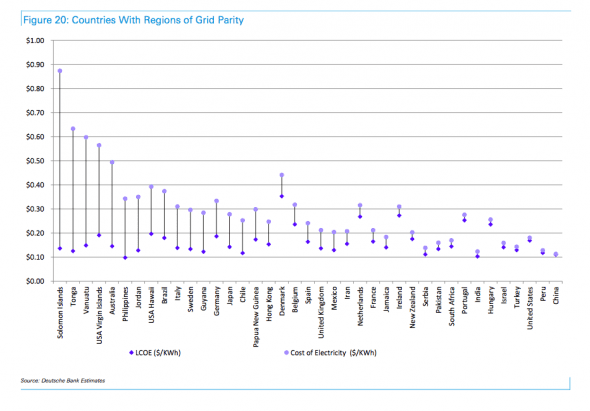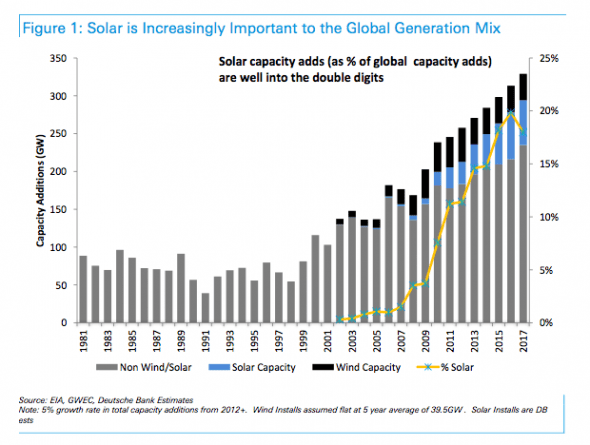 |
| A local microgrid in Sendai, Japan (Photo credit: Wikipedia) |
Investment bank Deutsche Bank is predicting that solar systems will be at grid parity in up to 80% of the global market within 2 years, and says the collapse in the oil price will do little to slow down the solar juggernaut.
In his 2015 solar outlook, leading analyst Vishal Shah says solar will be at grid parity in most of the world by the end of 2017.
That’s because grid-based electricity prices are rising across the world, and solar costs are still falling. Shah predicts solar module costs will fall another 40% over the next four to five years.
Even if electricity prices remain stable - two thirds of the world will find solar to be cheaper than their current conventional energy supply. If electricity costs rise by around 3% a year, then Deutsche’s “Blue sky” scenario is for 80% of countries to be at grid parity for solar.
“We believe the trend is clear: grid parity without subsidies is already here, increasing parity will occur, and solar penetration rates are set to ramp worldwide,” Shah notes.
Deutsche Bank says unsubsidised rooftop solar electricity costs anywhere between $US0.13 and $US0.23/kWh today, which is well below retail price of electricity in many markets globally.
“The economics of solar have improved significantly due to the reduction in solar panel costs, financing costs and balance of system costs,” it notes. And further cost falls over coming years will come from improved panel efficiencies, and falls in balance of system costs due to scale and competition.”

The cost of finance will also fall, partly due to the development of new business models and partly because customer acquisition costs will fall as more consumers turn to solar and from the adoption of energy storage.
Shah says it is clear that solar is becoming an increasingly important component of the world energy market. This graph shows its rapidly rising share of new generation.

And while short term policy fluctuations and uncertainty - in particular in Japan and UK - have caused it to revise down total uptake in 2014 and 2015, Deutsche Bank says demand for solar in the world’s two biggest economies is about to “take off”.
In the US, solar demand is expected to jump five fold to 16,000MW in 2016, making it the biggest market in the world ahead of China (which is expected to be about 13,000MW a year).
The US market will be underpinned by a sharp rise in rooftop solar demand and the expansion of solar leasing, as well as new sources of financing.
Oil market slump will not have huge impact
Shah downplays the impact of the oil price slump, noting that oil account for just 5% of global electricity production - and barely registers in the most important solar markets such as US and China. In addition, even at prices of $US50/barrel, oil still cannot compete with solar.
“The cost of oil based electricity generation even at $50 oil prices is the 7-9c/kWh range and as shown in the note, the marginal cost is higher than solar in many regions worldwide,” Shah writes. “Bottom line is that oil prices do not have a material impact on solar demand.”
Utilities begin to turn to solar
And because the rooftop market is linked so closely to the price of grid electricity, Deutsche says that companies with exposure to distributed generation are best positioned to capitalise on the long term fundamentals of the market.
This fits in with the recent decision by European giant E.ON to dump its conventional electricity business and focus instead on distributed generation, for leading US generator NRG to also focus on solar and storage, and for Australian utilities such as AGL Energy and Origin Energy to roll out leasing programs.
Indeed, Shah says that 2015 will signal a change when major utilities turn to solar, while others continue to fight it (he’s talking about the US, although in Australia we are witnessing the same trend, albeit by the same utilities both arguing against solar incentives, and rolling out their own leasing models).
“We see the beginnings of what could indicate a long term shift in how utilities and their regulatory commissions interact with solar,” Shah notes. “In 2015, we expect several key decisions from utility regulators to continue shaping this debate.”
The argument over solar contributions
The key, then, will come around the framing of tariffs for solar energy. Shah neatly summarises some of the arguments over solar and tariffs this way:
Some utilities argue that solar installations do not pay enough to support the grid, because transmission and distribution charges are generally based on metered electricity use. When a solar installation connects to the grid, it generates a portion of the owners electricity use and effectively acts as a reduction in grid demand. In most cases, this leads to a proportional decrease in the dollar charge for grid-sourced electricity (which includes a proportional charge for T&D cost recovery).
Solar companies, individual users, and freedom-of-choice advocates believe this representation does not accurately account for the positive external contributions that solar installations provide. Theoretically, large scale distributed generation adoption should lower peak electricity demand, reduce strain on the grid, provide emissions-free electricity with no fuel cost, and lower the amount of necessary future investment in the grid on all fronts. In a scenario where ‘smart grids’ allow distributed solar resources to be dispatched as requested by the grid operator, the benefits from DG installations should increase.
Long term, we believe the business models for solar and utility companies will necessarily shift as grid penetration rates increase (currently no more than 1-2% in even the high penetration states). Grid access charges could increase, utilities may start to compete more directly with solar installers, and cost recovery mechanisms generally will go through a rigorous analysis in most major solar markets.
No comments:
Post a Comment